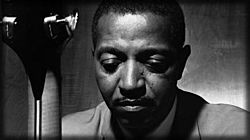Freddie Green facts for kids
Quick facts for kids
Freddie Green
|
|
|---|---|
 |
|
| Background information | |
| Birth name | Frederick William Green |
| Born | March 31, 1911 Charleston, South Carolina, U.S. |
| Died | March 1, 1987 (aged 75) Las Vegas, Nevada, U.S. |
| Genres | Jazz, swing |
| Occupation(s) | Musician |
| Instruments | Guitar |
| Associated acts | Count Basie Orchestra |
Frederick William Green (born March 31, 1911 – died March 1, 1987) was an American jazz guitarist. He was famous for playing rhythm guitar with the amazing Count Basie Orchestra for nearly 50 years! He helped create the band's unique swing sound.
Contents
Growing Up and Learning Music
Freddie Green was born in Charleston, South Carolina, on March 31, 1911. He grew up surrounded by music. He first learned to play the banjo. When he was a teenager, he switched to the guitar.
A friend of his father, Sam Walker, taught Freddie how to read music. Sam really encouraged Freddie to keep playing the guitar. Freddie even got his first chance to play for an audience with a local group that Sam organized. Another person in that group was William "Cat" Anderson, who later became a famous trumpet player with Duke Ellington.
Becoming a Jazz Star
After his parents passed away, Freddie moved to New York City to live with his aunt and finish school. This move opened up a whole new world of music for him. While still a teenager, he started playing in clubs around the city. He earned money and became well-known.
At one of these gigs, a famous talent scout named John H. Hammond noticed Freddie. Hammond saw how talented Green was and introduced him to Count Basie.
In 1937, Basie and his band went to hear Freddie play. Basie loved his style right away and offered him a job. Except for a short break, Freddie Green stayed a very important part of the Count Basie Band for the next 50 years.
"You should never hear the guitar by itself. It should be part of the drums so it sounds like the drummer is playing chords—like the snare is in A or the hi-hat in D minor"
—Freddie Green
Throughout his career, Green played rhythm guitar. This meant he played chords to support the other musicians, keeping the beat and harmony. He rarely played solos. His great timing and smooth harmony helped make the rhythm guitar a key part of any jazz band.
Freddie did play one solo at a big concert in Carnegie Hall on January 16, 1938. This concert featured the Benny Goodman big band. During a jam session on a song called "Honeysuckle Rose," Green was the rhythm guitarist. After another musician's solo, Benny Goodman surprised everyone by signaling for Green to play a solo.
Freddie changed chords very quickly, sometimes with every beat. He often used his fingers to cover four strings, but only pressed down on some of them. He also used his left hand to quiet the strings he wasn't playing. His unique way of playing his special Stromberg guitar became a model for other big-band guitarists.
Freddie Green didn't write many songs, but he did create two important ones for Count Basie's band: "Down for Double" (recorded in 1941) and "Corner Pocket" (recorded in 1955).
On March 1, 1987, Freddie Green passed away from a heart attack in Las Vegas, Nevada. He was 75 years old.
Music He Made
Freddie Green made music as a band leader and with many other famous musicians.
As a Leader
- Mr. Rhythm (RCA Victor, 1955)
- Rhythm Willie with Herb Ellis (Concord Jazz, 1975)
Playing with Count Basie
Freddie Green played on many albums with the Count Basie Orchestra, including:
- The Original American Decca Recordings (GRP, 1937–39 [1992])
- April in Paris (Verve, 1956)
- The Atomic Mr. Basie (Roulette, 1957)
- First Time! The Count Meets the Duke (Columbia, 1961)
- Sinatra at the Sands (Reprise, 1966) with Frank Sinatra
- Basie Straight Ahead (Dot, 1968)
- Satch and Josh (with Oscar Peterson)
- Me and You (Pablo, 1983)
Playing with Other Artists
Freddie also played with many other jazz greats, such as:
- Buck Clayton
- Al Cohn
- Paul Quinichette
- Joe Newman
- Sarah Vaughan
- Charlie Parker
- Buddy Rich
- The Manhattan Transfer

